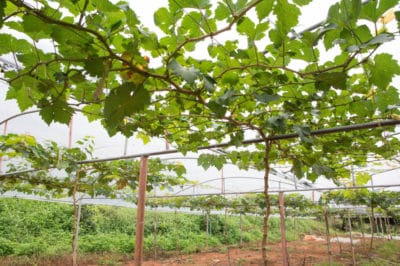Why do grape vines require support?
One reason for providing a trellis or arbor for your grape plants is obvious: Grape clusters are heavy! A plant laden with 40 or 50 bunches of grapes will bow under the weight of its fruit, causing damage to the vine. But there are more reasons to provide a growth structure for your grapes. Plant health and fruit production are also aided by a trellis.
There are more benefits to the trellis, too. Harvesting grapes is much easier when your vines are trained along wires or wooden frame, giving you much better access to the clusters of grapes. Weeding your vineyard is also simpler when the leaves and branches are growing above the ground and out of your way.
How is the plant helped by a trellis?
A trellis, arbor, arch, or other supporting structure helps you determine the direction of your plant’s growth. Additionally, visibility of the plant’s growth and easier access to the vines and branches means pruning is simpler and more effective.
By spreading the leaves of the vine along the trellis, more sun is able to reach the plant; grapes love sunshine, so the increased light encourages additional growth. The spreading of the plant’s greenery also improves air circulation throughout the plant which helps reduce diseases caused by excessive moisture build up.
Finally, grapes like warm soil and keeping their vines above the ground lets the sunshine reach the earth and keep the dirt nicely heated for a happy, productive plant.
What kind of supports are there?
Most of us have seen the traditional t-shaped trellis that fills most vineyards and gardens, and this is an efficient and effective method of supporting grape vines. There are, however, other means of training and supporting your vines.
- The high cordon trellis is the most commonly seen arrangement. It is well suited to American grape varieties and is just a single wire strung between posts just far enough apart to provide support for the wire. The plant’s vines are trained to grow along the wire. This method works best when your vines are planted at least six to eight feet apart.
- The umbrella kniffen system, is similar to the high cordon, except that it involves two wires – one above and one below – stretched across the posts. The main trunk grows to the top wire then the four spared canes are bent over and trained to grow along the lower wire. This creates the umbrella effect the method is named for.
- Another trellis system, the vertical shoot position, is an excellent choice for French varieties of grapes. This is a system involving six to eight wires along posts, and causes the vines to grow in a hedge-like arrangement.
It’s not just trellises, though!
You can use other things to support your grape vines though; a professional trellis system isn’t the only option. A garden arch is a great choice for using your grape vines in decorative fashion. The height and ladder like cross-bars of the structure are just made for training your vines while promoting the development of plenty of fruit.
Other options for your trellis include hog wire fencing on posts, wooden arbors, and various constructs available from your local garden or home improvement retailer. There are ideas all over the internet, too. For example, your vines can be trained along wood and wires arranged to create a tunnel, or to grow over the top of a garden swing frame.
Whatever arrangement or construction you use to support your grape vines as they grow, their use is imperative. Grapes left to grow undirected will tend to grow little to no fruit, are difficult to prune, and are susceptible to disease.
